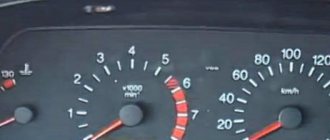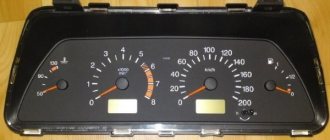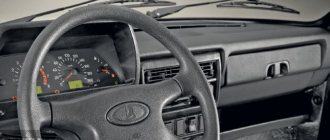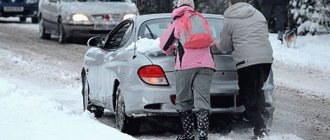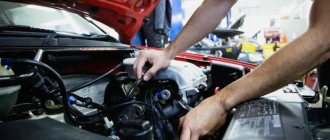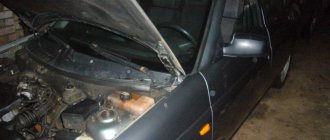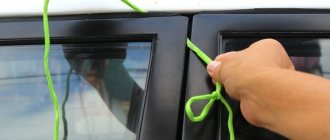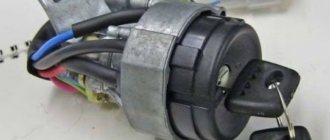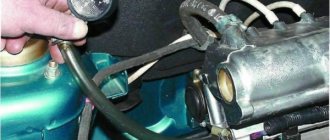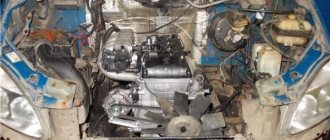The engine starts and stalls: troubleshooting
So, if a similar problem appears, then it is necessary to take into account a number of features. First of all, the operation of the internal combustion engine after startup will be influenced by the following factors:
- fuel supply;
- air supply;
- spark on spark plugs (for gasoline internal combustion engines);
- correct operation of glow plugs (for diesel engines);
- proper operation of the ECM and electronic sensors;
In this case, malfunctions
CPG
, low compression, significantly out of phase
timing belt
and other nuances in this case are taken into account, but do not come to the fore. The fact is that if there are serious problems, the power unit will most likely not start even for a short time.
With that said, you should first start by checking the main possible causes:
- Quite often, malfunctions in the operation of the alarm system and the anti-theft system can cause the engine to fail to operate after starting. In other words, the immobilizer does not turn off and continues to block the start of the internal combustion engine, which is its main function to prevent vehicle theft. If the alarm blocks the engine, then you need to check the operation of all elements, try to reset the error, turn off the anti-theft system, etc.
- Problems with the IAC and idle air valve often arise due to contamination of these elements. You should also pay attention to the cleanliness of the throttle valve. As for the crankshaft sensor, incorrect data that it transmits to the ECU can cause the engine to stall immediately after starting.
- Poor quality fuels and lubricants can also cause problems. As a rule, problems begin in cases where low-grade fuel was filled or the engine uses motor oil that does not meet the recommendations/has lost its properties.
- A faulty fuel pump, air leaks in the fuel line, the formation of air pockets and dirty fuel filters do not allow creating the required pressure in the power system or supplying fuel in the required volume.
- The air filter and its contamination leads to the fact that the working mixture is significantly over-rich. In other words, the engine does not have enough air to burn fuel, and the spark plugs flood.
- Problems with ECM sensors (EGR sensor, oxygen sensor, DPKV, etc.) can lead to both unstable engine operation at idle and a complete engine stop after starting.
We also recommend reading the article about
why does the engine stall when braking?
. From this article you will learn about the reasons why the power unit begins to operate unstably or the engine stalls after pressing the brake.
Now let's look at the most common problems and how to fix them, looking at them in detail.
- First of all, the culprit may be the low level of fuel in the gas tank and its quality. If gasoline or diesel fuel runs out, then the engine will start using the remainder in the power system, but further operation will be impossible.
As for quality, unscrupulous sellers can use both various additives and ordinary water to dilute fuel. To check this, part of the fuel is poured into a transparent container, after which it is necessary to allow the liquid to settle.
Water is heavier than gasoline and settles to the bottom. If this is the case, then the problem has been identified. To solve this, it will often be enough to dilute the existing fuel with high-quality fuel, after which the engine can usually be started.
However, this doesn't always work. It is possible that the supply of low-quality fuel in the tank will need to be completely drained, after which the power system will be thoroughly cleaned and flushed.
If the malfunction occurs on a diesel engine, then problems with fuel can lead to more serious consequences. For example, if a diesel engine starts and stalls in winter, then the cause may be waxed and frozen diesel fuel. In this case, diesel fuel needs to be heated, filters cleaned, etc.
It is much worse if gasoline accidentally gets into the tank of a diesel car. In such a situation, there is a high risk of serious damage and failure of expensive diesel engine fuel equipment (fuel pump, injectors).
- The next reason why the engine starts, runs and stalls may be the battery. The fact is that many systems and actuators require sufficient battery charge for normal operation.
We are talking about the fuel pump and ignition system, which consume electricity from the battery not only at the time of start-up, but also after the engine has started running. As a rule, if a working starter has difficulty turning the engine, then this indicates a severe discharge of the battery.
- Another element that is worth paying attention to in the event of a sudden stop of the internal combustion engine after starting is the fuel pump. On modern fuel-injected cars, the fuel pump is located in the fuel tank.
In order to check its operation, you need to turn the key in the lock, turn on the ignition and listen carefully. In the first seconds after turning the key, a characteristic light hum/buzz should be heard. This sound lasts for several seconds, indicating that the fuel pump has started working and is building pressure in the fuel system.
If such a sound is not heard, then it is necessary to determine the reason why the gas pump does not pump gasoline. The pump motor itself, the fuel pump relay, fuses and other electrical circuit elements may fail. Let's also add that the ECU can turn off power to the pump if the crankshaft sensor does not send a signal.
It is also important to consider that the filter mesh on the fuel pump may become clogged. For accurate diagnostics, it is advisable to measure the fuel pressure in the fuel rail using a pressure gauge.
Another common cause may be the fuel filter. If it is contaminated, then a decrease in throughput leads to the fact that the pump cannot pump gasoline in the required volume for normal engine operation. As a result, the unit stalls after starting.
- If there is fuel in the system and the pressure is normal, then the problem may be related to the ignition system. Most often, spark plugs and spark plug high-voltage wires fail. A typical symptom for wires is that the engine stalls after washing or in wet weather.
One way or another, you need to unscrew the spark plugs, clean the elements, and check them for a spark. If the spark plugs have not been changed for a long time, then it is better to immediately install a new set. As for armored wires, they also need to be checked for functionality and replaced if necessary. At the same time, on some cars you need to check the ignition timing.
- The synchronous operation of the valve mechanism may be disrupted due to the fact that the timing belt or chain may be incorrectly installed, stretched, worn out and may jump on the pulleys. As a result, the opening and closing of the intake and exhaust valves does not correspond to the engine strokes.
In this case, to eliminate the problem, you need to check the indicated elements, align the timing belt to the marks and perform other necessary procedures.
- ECU malfunctions are less common, but this possibility should not be ruled out. Cases where the controller was reflashed, chip tuning was performed, or LPG was installed on the car deserve additional attention.
Regarding the various sensors, attention should also be paid
Mass air flow sensor
And
TPDZ
, as well as the oxygen sensor in the exhaust system (lambda probe). If on the dashboard
"check" is on
during a short-term start of the internal combustion engine or no signs of problems are visible, it is still necessary to perform
computer engine diagnostics
.
You can do this diagnosis yourself. To do this, you will need an adapter for the OBD2 diagnostic connector, which will allow you to read error codes and display the received information on the screen of a tablet, laptop or smartphone.
Why does the engine stall after starting?
Most often, the reason that the engine stalls after starting is a breakdown of the idle air control.
Domestic cars are more susceptible to this “disease”. In second place is an injector malfunction associated with a modern fuel injection system, which is carried out forcibly. It is possible that problems may be found in the operation of the fuel pump and in the ignition. The engine crankshaft timing sensor may have failed. These are the most common causes of a stalled engine. Much less often, when the engine stalls after starting, the electronic control unit (ECU) and failed injectors are to blame. In the latter case, this circumstance can affect the operation of the engine only if the operation of several at once is disrupted - and this is an exceptional phenomenon.
We carry out diagnostics of IAC
Now that the range of possible problems that can cause the engine to stall is approximately outlined, we will tell you how you can effectively diagnose this or that breakdown. Let's start with a malfunction of the idle air control. In the event that he is the culprit, the engine may behave like this:
1
.Do not start or stall immediately after a short stop during a long trip.
At the same time, the engine is hot; 2
.
You eventually managed to start the engine, which stalls after starting, but the normal idle speed was not set immediately, but only after pressing the gas. This situation can occur with either a hot or cold engine; 3
.
The engine can only be started with the gas depressed, otherwise the engine will immediately stall; 4
.
In order to start the engine, you have to hold the accelerator pedal constantly while the engine warms up, or until the car moves off; 5
. Idle speed hanging within 1500-2000 rpm also indicates a malfunction of the idle speed controller.
If after the diagnostics you are sure that the problem is in the IAC, then you should wash it and the throttle assembly, and in extreme cases, simply replace the idle air control with a new one.
If the most common reason that the car stalls immediately after starting the engine is not confirmed in your case, we will look for the breakdown further. A little experience and the ability to listen to your car will help you determine the performance of the fuel pump by sound. As an alternative method, you need to check the wiring by applying 12 V to the fuel pump, while you need to monitor the pressure in the fuel system, it should be within 2-3 bar. The pressure should not drop immediately after the fuel supply to the engine is stopped. If this does happen, check the fuel pressure regulator.
After this, in order to determine why the engine stalls after starting, we will check the ignition (in order not to burn the electronics, we connect the spark plug to ground). It happens that a rather trivial connection failure is to blame for the breakdown. Check this by wiggling all possible connections and visually verifying the integrity of the wiring. But if the ECU itself is faulty, then you can easily determine this from the error sensors. Checking the voltage in the network. When the engine is not running, it should be 12.5 V, when the engine is running 14 V, and when the engine is started 8 V. Well, as the last point in diagnosing the reasons why the engine stalls after starting, it is worth checking the integrity of the camshaft drive belt and pulley.
Thus, we have carried out a superficial diagnosis of the reasons why the engine stalls after starting, accessible to a simple car owner and not requiring special equipment. If you are unable to identify the problem, we strongly advise you to contact a specialist. In the meantime, let’s talk about proactive actions that will help you avoid getting into such a situation.
The easiest way to avoid costly repairs in the future is to properly operate your vehicle. Here are the basic, simple rules:
1
.Try not to start the car by towing or pushing it down a slope;
2
.
Do not allow water to enter the injector or carburetor; 4
.
Change fuel filters; 5
. Get your maintenance done regularly.
Source
The required amount of fuel is not supplied
The photo shows the fuel pump.
Most likely, the problem lies in the pump, which in the vast majority of cars is located in the fuel tank. This pump either fails or its fine mesh becomes clogged.
- Read about replacing the fuel pump
There may be a lot of debris and water in the fuel tank. The mesh catches and delays all this, acting as a filter. In the warm season, all this debris does not interfere with the normal circulation of fuel; it easily enters the combustion chamber. But in winter there is a different picture. In cold weather, water and debris freeze to the mesh rods, and fuel can no longer pass through the mesh at the required speed. And if you manage to pump a little more to start the engine, then you can’t get it to work! Actually, for this reason the engine stalls. Cleaning the mesh is not difficult - the main thing here is to get to the fuel pump.
1. Malfunction of the anti-theft system.
Failure may occur as a result of:
- attempts to start the engine with the key of another car;
- alarm activation;
- failure of the key chip;
- extremely low battery charge.
A malfunction of the immobilizer system is often reflected on the device screen in the form of a key. Some devices notify you of a problem with a yellow LED signal or the inscription 'IMMO'. Trying to configure the device yourself can make the situation even worse, so it is better to contact a specialist who has the appropriate equipment. Such repairs will cost a small price.
Don't panic
When the engine starts and immediately stalls, many drivers begin to panic a little, because not every driver can immediately identify this malfunction. Pulling on wires, pipes, kicking the car wheel out of helplessness, as a rule, does not produce results.
Usually the car will start after a while, and then the situation may repeat itself.
I would like to note that the reason when the engine starts and immediately stalls can be various malfunctions specific to a particular car model, ranging from a malfunction of the VVT-i valve, or more precisely due to its clogging, and ending with burning of the fuel pump relay contacts which often happens on Honda cars.
It is worth noting that recommendations are given here not for complete dummies, but for those who can already independently perform simple work to identify the malfunction and eliminate it.
For people who do not understand anything about these issues, it is better to immediately go to a car service center, and if the engine starts and immediately stalls, and this is repeated several times without success, call a tow truck.
The valves are malfunctioning
When the engine starts and stalls, the cause of the breakdown is hidden in the operation of the valves (this applies to the gasoline model of the engine). Diesel options are characterized by a decrease in fuel pressure. For repairs, you should contact a service station, where they will carry out appropriate diagnostics and adjust the valves and adjust the operation of the timing belt.
Problems most often can be:
Each of the listed breakdowns can occur with a car, and the issue can only be resolved with the help of appropriate specialists. When the driver has the skill to adjust the timing belt, you can do the repair work yourself. If malfunctions are observed in winter, you should, if possible, put the car in a warm box for a while, and the problem of starting/stopping the engine may disappear on its own.
Symptoms under a microscope
How do motorists usually describe a malfunction? Long story short, the car started and immediately stalled. If deployed, the engine started and immediately stopped after a couple of seconds. Observations are sometimes supported by numbers. For example, the speed at start drops to 500 rpm and the car stalls.
Sometimes the problem can be resolved by pressing the gas immediately after starting the engine. In some cases this helps. And sometimes it’s useless, the engine still doesn’t hold speed. But it’s worth trying to press the accelerator pedal immediately after starting in any case. It is quite possible that this action will help you get to the nearest repair site on your own.
Most common reasons
A car engine – gasoline or diesel – can stall in a variety of conditions. The car owner can solve the problem in any way - drive to a service station and entrust the car to the care of the service technicians, or try to eliminate the problem on their own.
If the car starts and stalls after a few seconds, it is necessary to find the reason for this “behavior” of the engine. Depending on the nature and severity of the breakdown, a decision is made on how to fix it. It happens that repairs not carried out on time lead to aggravation of the situation - costs increase.
Engine stalls on cold start
If the car starts and immediately stalls when cold, it is impossible to say for sure why this is happening. There are several possible reasons for this situation.
Why does the engine start and immediately stall:
If your car starts and immediately stalls, most likely the problem is due to one of the above reasons. And they apply to cars with different types of engines. But there are situations that are typical only for injectors.
On a note! If the fuel has been diluted with water, but it is relatively small, it is recommended to use moisture removal products. Or you will have to drain the fuel, change the filters and fill in with new, high-quality fuel.
Why does the injector stall?
Currently, most cars are equipped with injection engines. An injector is an element of the fuel supply system that injects fuel into the engine.
If a car with an injector stalls after it starts, the reason must be sought among the following situations:
On a note! To check the spark plug, attach the armor wire to it, and then turn the crankshaft with the starter.
Other reasons
In practice, auto repairmen also encounter other, less common reasons for the engine not working correctly when starting, as a result of which it stalls.
Why else may the car engine not start:
Most of the breakdowns that cause a car engine to stall are difficult to diagnose on your own. As a rule, only experienced auto repairmen can understand the problem. The driver’s task is to try to start the engine in order to get to the nearest service station.
Fuel quality
It is quite easy to come across fairly low-quality and trivially diluted diesel fuel or gasoline at domestic gas stations. It causes the engine to stall because there is a lot of water in the fuel. The optimal solution would be to drain the liquid and fill the tank with a high-quality composition.
Other situations also occur with diesel engines when, during severe frosts, paraffins harden, causing fuel filters to become clogged, pressure in the fuel line drops, and the car stalls. It is recommended to check the condition of the glow plugs. If you wish, you can use special additives called antigels. When there is excess water, moisture removers sometimes help. But since these are additives, motorists have different attitudes towards them. They will definitely not force their use.
By the way, write in the comments how you feel about additives and how often you use them. It will be interesting to know your opinion on this matter.
depressurization of VUT, malfunction of the fuel pump, fuel filter
A situation in which the car stalls immediately when you press the brake can occur at any time and does not depend on the type of engine. There are many reasons leading to a malfunction. This situation not only causes discomfort during the trip, but can also provoke a dangerous accident.
Most often, the problem lies in one or another malfunction of the brake system. In order to accurately find out the cause of the malfunction and eliminate it as soon as possible, it is worthwhile to fully diagnose the car and stop driving it for a while.
Main reasons
There are quite a few reasons why a car stalls even when braking smoothly. Most often these are the following malfunctions:
- if the car has an injection engine, then problems often arise in the operation of the idle speed sensor;
- breakdown of the VUT or depressurization of its hose;
- incorrect functioning of the fuel pump;
- malfunctions in the car's electronic control unit.
Depressurization of VUT or its hose
If the car starts to stall when braking, then the first thing you need to do is check the brake system, namely the vacuum booster and hose. It's quite easy to do this:
- Amplifier. Its weak point is the membrane, it is located between the brake pedal and the master cylinder. Due to the violation of its integrity during braking, a large amount of air accumulates in the brake fluid, so the engine stops. Checking the serviceability of the membrane is very simple. After the engine has been running for some time, you need to press the brake pedal and turn it off. The pedal is held down for 30 seconds. If the pedal offers no resistance and does not rise, then everything is fine. Otherwise, you will have to go to a car repair shop to replace the amplifier with a new one, since this unit is not repairable.
- Hose. Its depressurization due to damage leads to a lean air-fuel mixture, which causes the engine to quickly stall. Finding out that a part is faulty is quite easy. It is necessary to conduct a visual inspection for existing damage. Additionally, it is worth disconnecting the vacuum booster and the hose. The free end is clamped with your fingers and the engine is started. When the hose is sealed, the engine speed will immediately increase, otherwise there will be no visible changes in operation.
If the reason for the engine stopping is problems with the VUT, then it is important to eliminate them as soon as possible, and until then not to use the car, as the risk of getting into an accident increases many times over
The reason is the fuel pump and fuel filter.
The situation is a little more complicated if the fuel pump is damaged. Its proper operation can be checked using a monometer; it determines the pressure level in the fuel line. In other cases, you can disconnect the fuel outlet hose from the pump and try to bleed it. If it is working properly, fuel will come out of the hole. If this does not happen, then the part is dismantled and sent for diagnostics. Depending on the complexity of the damage, it can be repaired or replaced with a new one.
Idle speed sensor malfunction
This device allows the engine to maintain a certain number of engine speeds when the driver stops pressing the gas pedal. If there is a malfunction in the sensor, then floating idle speed becomes clearly visible.
It is not difficult to identify a malfunction: the control circuit of the sensor is called with a tester, after which a decision is made to repair or completely replace the part.
Other reasons
The malfunctions described above are not the only reasons why the car stalls when you press the brake. The following malfunctions often lead to this problem:
- spark plugs unsuitable for further use;
- problems arising in the on-board electrical network;
- exhausted injectors;
- throttle valve clogged.
To diagnose and fix these problems, you should contact a car repair shop, and this must be done as soon as possible. Malfunctions that occur in the braking system pose a serious threat to the lives of both the driver and passengers.
Irregularities in fuel supply.
One of the most common reasons is insufficient fuel or its poor quality. For example, leaving a car with a low level of gasoline, over time, condensation that rolls to the bottom of the tank allows you to start the engine, but not for long. In addition, cases of sale of fuel diluted with a special composition (for example, gasoline or plain water), including at gas stations, have become more frequent.
The specific composition of diesel fuel can affect the starting of a car in the winter season. The paraffin contained in it becomes hard on frosty days, which prevents it from passing through the filter. As a result, the fuel line suffers from low pressure. For such cases, special anti-gels have been developed, which should be in the arsenal of the owner of a diesel car.
2. Incorrect operation of the exhaust system
The photo shows mounting foam in the exhaust pipe.
You can conduct a simple experiment: cover the exhaust pipe with a rag and start the engine. After about ten seconds it will stall, and if you remove the rag and start it again, it will stall again. This happens because the gases resulting from combustion are not exhausted through the exhaust system, but are mixed with the air entering the engine. If there is insufficient air mixture, the engine simply cannot burn fuel normally and stalls.
In the photo there is ice in the exhaust pipe
There can be two reasons for this phenomenon: clogging of the muffler itself or water getting into it. It happens that the water freezes. Of course, this rarely happens, but this possibility should not be completely ruled out. Also, some “prankster” may stick a plastic bag or stone into the exhaust pipe. In a situation where the engine cylinder head gasket is worn out, when antifreeze disappears, water may enter the muffler.
The first step is to get rid of the water in the muffler, and then look for the cause of its appearance.
What to do
If the engine jerks at idle, the cause should initially be determined. Then replace the damaged unit.
For carburetor models, the primary diagnosis begins with the throttle and the combustible mixture formation unit itself. Usually on old foreign cars and VAZs the root of evil is located here.
If the problem arose on a modern VAZ 2114/15 or on an “exotic” model like 1JZ-GE. The source of the problem may be inside the sensors. First of all, the DPKV, temperature sensor, temperature control system and others are checked. If everything is in order, you need to move on. High-voltage wires, spark plugs, and the ECM are diagnosed, and the ECU is checked last.
The car jerks at idle and when driving
If the problem occurs not only while parked, but also while driving, it is necessary to check the ignition, carburetor, and serviceability of the throttle valve.
For the injector, diagnostics of the fuel rail, its pressure, tightness, and the condition of the injectors are appropriate.
Also in both cases, the electronic part is diagnosed: control units, distributor, wiring, spark plugs.
The malfunction is caused by a failure, incorrect operation, of one of the vehicle systems.
The injector jerks
Main reasons:
- injectors or individual fuel supply elements are clogged;
- ignition coils are not working properly;
- The ECU and sensors are not functioning correctly.
The carburetor jerks
Everything is simpler with a carburetor. Here's what you should check:
- throttle valve condition;
- filters;
- spark plugs;
- distributor;
- Is the fuel pump working correctly?
At idle the car jerks and stalls
If the engine does not idle during a cold start in winter, there is nothing terrible - the block will warm up and everything will return to normal. However, if there is a failure after warming up, there may be several reasons for the breakdown.
- Idle air control failure.
- Clogged, throttle malfunction.
- The carburetor and jets are clogged (the injectors are checked for the injector).
- The fuel supply pump is faulty.
- The air/fuel filter is worn out.
- Failure of the electronic sensor MRV, TPS, DPKV.
The car shakes at idle
If vibration is transmitted to the car body, the first step is to check the wear of the power plant mounts. Squashed cushions do not reliably hold the engine in place, which causes severe shaking, deviation of the internal combustion engine from the nominal position and, as a result, vibration.
Other causes of shaking are described above.
The car shakes and jerks at idle
The process of engine tripping is a consequence of the malfunction of one or more cylinders. A similar breakdown is caused by a failure of the spark plug or a breakdown of the high-voltage wire.
- With the engine running, remove the spark plug cap from the first cylinder.
- After 3-4 seconds, install the element in place.
- Consistently repeat the procedure for all boilers.
During the check, you must listen to the sound of the engine. If the growling gets worse (the system doubles), the compartment is fine. If the result is neutral (nothing has changed), it is worth checking the line completely for serviceability.
The primary source of failure may be the following reasons:
- incorrect mixture setting - the cylinder floods;
- spark plug or wiring is of poor quality;
- occurrence of rings;
- piston wear.
Diesel car jerks at idle
There can be only three reasons here.
- The cylinder compression has dropped. As a rule, this occurs due to burnout of the cylinder head gasket and wear of the piston group elements.
- Injector problems - poor mixture supply, blockages, intake failure.
- Malfunction of the injection pump.
The car on gas jerks at idle
If a breakdown is detected, it is strictly not recommended to interfere with the unit yourself. You must contact a qualified gas fitter.
Interruptions on a cold engine
If the engine stalls at idle and then levels out after warming up, don’t worry too much. When cold, the power plant does not have normal clearances and can operate unstably. After reaching the design temperature, the motor stabilizes and stops twitching.
If the vibrations are strong and prolonged
When vibration in the engine does not disappear, but persists for a long time, this may indicate problems:
- wear of the piston group;
- violation of internal combustion engine fasteners;
- incorrect operation of the fuel system;
- ignition problems.
Diagnostics
You can identify the specific reason why the engine stalls after a cold start by checking all components. Non-working elements are changed or repaired if they are repairable.
Advice! On vehicles equipped with an on-board computer, computer diagnostics will be required using a scanner with OBD-II protocol.
OBD 2 connector
If there is no device, the car is taken to a service station. The master diagnostician will connect the scanner, count the errors, and develop a recovery plan based on them. In cars where there is no on-board computer, they are diagnosed by searching through all the components, which takes a lot of time.
Active alarm
I can’t say that the situation is very common, but sometimes it occurs. Plus, it is easy to deal with, since we are not talking about malfunctions of the engine or other systems.
Some cars have an alarm that blocks not only the door locks or steering wheel, but also the engine. The system works in such a way that after an unauthorized start it literally stalls immediately. This is a fairly effective protection that does not allow you to drive far in a stolen vehicle. Check to see if your car has this safety feature disabled and try starting again.
Such security systems can currently be installed on any car, be it:
see also
- VAZ 2110;
- VAZ 2114 injector 8 valves;
- Volkswagen Passat B4;
- Mercedes E class;
- Lada Kalina;
- VAZ 2107;
- Renault Megane;
- Ford Kuga;
- Mazda 6;
- Audi A5;
- Honda Civic, etc.
How justified the costs of installing such an alarm will be, everyone decides for themselves.
Air supply problems.
Possible reasons include:
- the presence of a large amount of contaminants on the air filter;
- broken fuel pump;
- excess dust in the fuel filter.
Thus, a dirty air filter prevents the engine from receiving air. As a result of a lack of oxygen, the spark plugs turn black, excessive fuel consumption occurs, which ultimately leads to the impossibility of starting the engine. Failure of the fuel pump and dust on the fuel filter lead to disruptions in the power supply system and fuel supply.
3.1. Lack of vacuum in a car with a carburetor
In the absence of vacuum both in the carburetor and in the vacuum hoses with the intake manifold, an air-fuel mixture that disrupts engine operation is formed. Only checking the vacuum lines can help identify depressurization. Perhaps in this way any damage to pipes or hoses will be detected, replacing which will eliminate the problem.
3.2. Air damper malfunctions
The function of the damper in a carburetor car is to regulate the flow of air, creating the necessary mixture in the combustion chamber. The following can lead to the formation of a poor-quality mixture in the engine:
- breakdown of the mechanism that returns the damper to its seat;
- damage to the drive cable;
- excess dirt on the damper, preventing it from returning tightly to its original position.
Any of the reasons leads to the stop of the motor.
Why does the engine stall?
It starts, then while driving, then immediately stalls, the engine for a number of reasons:
- Poor fuel quality. The problem can be resolved by replacing the fuel filter.
- The spark plugs are clogged (large carbon deposits). The solution is to replace or calcinate the spark plugs.
- Clogged fuel cell. It's worth replacing.
- Air filter malfunction. The engine stalls due to insufficient oxygen supply, which leads to poor combustion of the working mixture.
- Generator failure or battery failure.
- Failure of the main sensors of the car.
4. Irregularities in the ignition system
Quite often, spark plugs or glow plugs, as well as high-voltage wires, need to be replaced. The car may stall immediately after turning the key as a result of:
- lack of distributor connection contact;
- damage to the ignition coil;
- breakdown of high-voltage wires.
Stopping the engine during rain or after visiting a car wash often indicates problems in the wires. And the loss of connection contact is often preceded by car repairs or replacement of any system. In any case, it is recommended to check the integrity and cleanliness of the spark plugs and their ability to conduct a spark. If the spark plugs were changed more than 30 thousand km ago, they should be replaced with new ones.
Injector malfunction
The next reason that the engine starts and immediately stalls is a malfunction of the injector. Since most modern cars have a forced fuel injection system, this malfunction is very common.
Don't make mistakes.
What should not be allowed when operating fuel-injected cars:
- Do not disconnect the battery while the engine is running.
- Try to play with lighting as little as possible, and in general, handle food as carefully as possible. Injection cars are very sensitive to such manipulations.
- Try not to disconnect the ground on the car. Although I turn off the mains in my car in winter if I don’t drive for a long time, and so far I have not noticed any discomfort in operation, although many experts say that it is possible to erase information in the computer. I just try to let the car idle for up to 3 minutes when starting the engine.
- Injector-injected cars are not very fond of charging and starting devices, since when they are used, the voltage jumps significantly and the ECU can burn out.
ECU board.
- If a neutralizer is provided in the design of the car, then try not to start the car by towing or pushing it down a hill, as unburned fuel is formed, which, if it gets into the neutralizer, can ignite spontaneously.
- Do not allow water to enter the injector; this is strictly contraindicated. To do this, change fuel filters in a timely manner and fill with high-quality gasoline.
What does a neutralizer look like?
- If your car is equipped with an L probe and a neutralizer, then think about whether you should take the risk by using leaded gasoline. When using such gasoline, the L-probe, in addition to the fact that it itself can quickly break down, it will transmit incorrect data to the ECU, indicating a large amount of oxygen, and this, to put it mildly, is not very good, as it can lead to local overheating of the engine .
So, we return again to our problem, the engine starts and immediately stalls or does not start at all.
The car stalls at idle or immediately after starting. What is the reason?
An unexpected engine stop while idling is a phenomenon that inexperienced motorists attribute exclusively to the products of the Soviet, and then Russian, automobile industry, and, of course, the automobile industry of the former republics of the USSR.
However, this problem also occurs on foreign cars, and even on luxury cars. Let's look at the main reasons that can lead to the car stalling at idle. And although carburetor cars are still found on our roads, quite often, we will mainly consider injection cars and their breakdowns that lead to a similar effect.
Problems with sensors and other electronics
Oddly enough, most often the spontaneous engine stop at idle is associated with various electronic components of the car. The first thing you should check is, of course, the idle speed sensor. It is sometimes called the idle air control (IAC), and is often confused with the throttle position sensor (TPS). (All about sensors here)
The idle speed regulator itself is designed to ensure that the engine operates at idle speed when the throttle valve is completely closed. There is a special bypass channel for this. It is this channel that opens the IAC. The bypass channel allows air to enter the engine bypassing the throttle. Accordingly, if the idle speed control does not work, air does not enter the engine and the engine stalls. The IAC can be replaced, but even if you installed the device correctly at the required distance, it needs calibration. To do this, you need to turn on the ignition for thirty to forty seconds and wait until the car’s electronics calibrate the new sensor.
Actually, the cause of problems with the engine at idle and not only can be the DPTZ - throttle position sensor. If this sensor gives incorrect information about the throttle position, the IAC may not work at all. Often, but not always, the check engine light will come on when the throttle position sensor fails. This combination allows you to correctly determine the reason why the engine stalls at idle.
In addition to the two devices described above, idle problems can be caused by:
Electrical problems
Often the reason that the engine refuses to idle is an incorrectly adjusted ignition angle. True, problems in this case are observed in all ranges of engine operation. All that is required to fix such problems is to set the ignition correctly and that’s it.
Spark plugs that are regularly filled with gasoline, or that have simply expired, can also cause the engine to stall at idle. In addition, you should check the ignition distributor, wiring and battery condition. Especially if the car is running rough, the engine is running rough, with jerks and dips.
Well, the starter will tell you in detail about the condition of the battery, especially on a cold engine. Most electrical problems can be diagnosed and fixed easily and without major investment.
Mechanical problems
The next group of breakdowns and malfunctions relates to the mechanical component of the car system. For example, the throttle valve. If it is clogged, the car may well stall at idle. It should be noted that a clogged throttle manifests itself in the fact that the car begins to respond worse to pressing the gas pedal. In this case, the throttle is removed and thoroughly washed with carburetor cleaning fluid.
Also, sometimes the car stalls at idle if there are problems in the vacuum lines of the fuel system. But here you can’t do without a good car repair specialist.
A clogged injector or carburetor, among other things, can also cause the car to stall at idle. It would also be a good idea to check the fuel and air filters, as well as the fuel pump.
In the cold season, problems with starting diesel cars are associated with crystallization of diesel fuel at low temperatures.
Another rather insidious and not particularly noticeable problem can be the EGR valve. The exhaust gas recirculation system is generally a very controversial thing. You can’t immediately tell whether it is more beneficial or, on the contrary, harmful. One way or another, a faulty EGR valve will successfully shut down your car’s engine in idle mode.
The car starts and immediately stalls
With some malfunctions, the car may start and immediately stall. Most motorists encounter such surprises in their practice. But the reaction of different people to such outrageous behavior of the machine will be very different. Experienced drivers will start looking for a fault, since they have at least a rough idea of where and what to look for. Beginners begin to rush around chaotically, imitating stormy but equally stupid activity.
How to fix the problem
When the fault has been identified, you should try to repair the unit. This is suitable for the fuel pump, engine valves, and other parts that are either impossible to repair or too expensive to buy.
It is better to contact professional mechanics for both diagnosis and repair. This will save time and also eliminate the worst consequences that will appear due to makeshift repairs carried out in person.
A running engine may stop working for several reasons, including problems with the ignition, fuel system, exhaust and other components. For an accurate diagnosis and professional repair, you need to turn to professionals, because otherwise the situation can only worsen.
Let's sum it up
If your car stalls for no particular reason and does not want to move, the problem may be hidden in the fuel system. Here it is important not to overdo it with your own study of the problem and not to get into the engine operating system yourself. The less personal intervention there is in a modern car during its operation, the more benefits you will receive from the flawless operation of the unit and its long service life.
However, there are situations when it is simply impossible to stop driving and call a tow truck. In this case, you should try calling the service center and asking for instructions for action. Perhaps specialists will offer you normal options for solving the problem, and will also remotely advise you on the right solution. If the machine has an old design, you will not have any problems with its technology. Have you ever encountered such troubles with a car?
Air filter
See also
If it becomes clogged, the intake manifold will begin to receive insufficient oxygen. This leads to so-called oxygen starvation.
A lack of air provokes the creation of a mixture too rich in fuel. As a result, the spark plugs will flood, they will begin to turn black, and fuel consumption will increase. But usually the engine still does not stall. It can turn off on the go in the most critical situation, when there is really practically no oxygen. Sometimes the engine cannot start at all, or turns off a few seconds after starting. There is nothing difficult in eliminating such a malfunction. Even a beginner can handle it.
You will need to find the air filter, check its condition, clean it or replace it. On many machines, the air ducts and filter housing also need to be cleaned.
Complete sabotage
The most deplorable situation, the engine does not start at all.
First of all, you need to maintain composure and not scold the car itself. Only after this, we calmly begin to find out the reason why the engine does not start.
Do not allow the battery to be severely discharged by pointlessly rotating the engine crankshaft, the energy will still be useful to you, but where you will charge the battery if you are far from home is the question. Although for the electronic unit itself 8 Volts will be quite enough. But, of course, they won’t be enough for the starter.
When you have calmed down, be sure to check:
- How does the fuel pump work and is there any fuel in the tank?
- Is there ignition?
- Is the engine crankshaft timing sensor functioning?
- Have the injectors failed, although the failure of several injectors at once is too much, this happens very rarely.
- The ECU is working. But this device also fails very rarely.
Diagnosis of IAC
How can you diagnose a faulty idle air control valve?:
- You stopped for 5 minutes after a long trip, naturally the engine is hot. After this, you try to start the engine, but the engine does not start or starts and immediately stalls. Even if the engine starts, the normal idle speed is not set immediately, but only after pressing the gas pedal more than once.
- The same situation can occur on a cold engine. The first time the engine starts and immediately stalls, but the second time it runs fine.
- Whatever the engine, hot or cold, it starts only when the gas pedal is depressed.
- The situation is the same as in point 3, but the accelerator pedal must be held constantly until the engine warms up or the car starts moving.
- You braked sharply and the car suddenly stalled; when you restart, the idle speed remains within normal limits.
- The idle speed hangs in an inflated range from 1500 to 2000 revolutions and only after revving it returns to normal values. Therefore, if your car’s engine starts and immediately stalls, try immediately flushing the throttle assembly and idle air control. If this doesn't help, just replace the IAC and that's it.
What does IAC look like?
Generator problem
The most important reason why the engine stops working under certain loads is a poorly working or not working at all voltage generator.
At
starting the engine
Energy is taken from the battery, and if the battery has sufficient charge, then the malfunction will not be immediately noticeable. But after working a little, the battery will begin to discharge, since the proper level of energy is not supplied to it. As a result, the engine stops due to a small amount of energy. If the battery was initially weakly charged, it may happen that the injector starts and stalls.
The car stalls due to sensors
The correct operation of the VAZ 2114 injector depends on several sensors:
- TPS (throttle position sensor);
- MAF (mass air flow sensor);
- DPKV (crankshaft position sensor);
- DTOZH (coolant temperature sensor).
If stalling of the car consistently depends on temperature (usually on a hot engine), the cause may be DTOZH. When cold, an enriched mixture is supplied to the injector. If, as the sensor warms up, it does not provide the correct data to the computer, the engine may become dull and stall.
The mass air flow sensor does not often manifest itself by stalling the car. Its “element”: failures when pressing the gas, increased fuel consumption, drop in power. But the VAZ 2114 may stall when pressing or releasing the gas if there are strong deviations in the real and measured amount of air. When you press the gas, the actual air flow increases. If the sensor gives the computer approximately the same readings as at idle, the mixture becomes very lean and the car may stall.
Mass air flow sensor VAZ 2114
Most often, the matter is solved by cleaning the mass air flow sensor. You can check it by disconnecting the chip while the engine is running. If the sound of the motor does not change, the source of the malfunction has been found.
TPS regulates the amount of fuel entering the engine. Contamination does not affect it as much as the mass air flow sensor, although sticking of moving parts is possible. Its main enemy is mechanical wear, which can only be corrected by replacement.
If the TPS is faulty, the car usually stalls when changing gears. This can happen when the gas is released or the engine speed drops, if the supply of the fuel mixture is momentarily blocked by the damper.
Throttle position sensor VAZ 2114
As a rule, TPS problems are not solved by cleaning. The sensor is checked with a multimeter. It is better to perform the operation together. Select the multimeter mode on the tester and set the probes to ground and the input signal - it should constantly show 5V. Then place the second probe on the third output (signal in the controller line). Have an assistant step on the gas. The voltmeter readings should vary within the range of ≈ 0.5 – 4 V. If there is no 5V power supply, the problem is electrical. If the sensor does not respond to pressing the gas or reacts incorrectly, replace the TPS.
DPKV is one of the rare reasons why a VAZ 2114 car stalls. There are several “old-fashioned” (inaccurate, so we don’t list them here) ways to check it. Ideally, the performance of the DPKV is checked with an oscilloscope, so we recommend that you always keep a spare sensor in the glove compartment. If other options have been exhausted, replace the DPKV with a known working one.
If the DPKV is faulty, the ignition does not work correctly: the injection phases are confused, the operation of the injectors and spark plugs does not match. The car may not start (most often) or start extremely poorly, stall and immediately stall, or run on gas on two cylinders.
The worst case scenario for why the car stalls when you let off the gas or at idle is that the cylinder head gasket is broken or the head is misaligned. In this case, engine repair will be required. There are so many reasons for such a malfunction, and the symptoms are so similar that diagnosis is mandatory. But even this does not always give results, pointing to the symptoms and not the causes of the car’s “disease”. Replacing the sensor may help, but after a while the problem will return.
You need to check each element one by one: starting with simple options and ending with complex ones (electrical breaks, uneven engine compression and its causes).
Why does the VAZ-2114 start and immediately stall?
Drivers probably face a problem when VAZ-2114
It starts and
immediately stalls
, the reason is hidden in every little thing.
This is a common situation that should not cause the driver to panic. This happens often, and it doesn’t depend on how well you can choose a studio or how long your car has been in use. There are many reasons why you will like this more, so you should be prepared for the fact that it will take some time. When the driver does not have the ability to independently figure out the cause of such a failure, it is best to contact an experienced specialist at a car service center. Sometimes the problem lies in the type of engine or in untimely technical inspection. Usually such problems arise abruptly and unexpectedly, which of course causes trouble for the driver.
6. Violation of the thermal clearance in the valves
It should be noted that it is recommended to inspect clearances on Russian cars at least once every 30 thousand kilometers. For comparison: owners of a foreign car only need to evaluate the condition of the gap once every 70 thousand. Why can a thermal gap affect the entire operation of the engine? The fact is that an unbalanced gap position leads to gradual tapping of the valves. This leads to a decrease in the life of the valve system and noisy engine operation. Failure to take action in a timely manner ultimately results in the vehicle being unable to start.
Thus, there are a great many reasons for the engine stopping after turning the ignition key. However, most of them are one way or another the result of failures in the fuel configuration, ignition system or electronic control. The operation of the motor may stop even as a result of severe wear. This will be indicated by worn cylinder walls and rings.
Source of the article with more detailed information and tables:
https://kak-pochemy.ru/pochemu-mashina-zavoditsya-i-glohnet/
